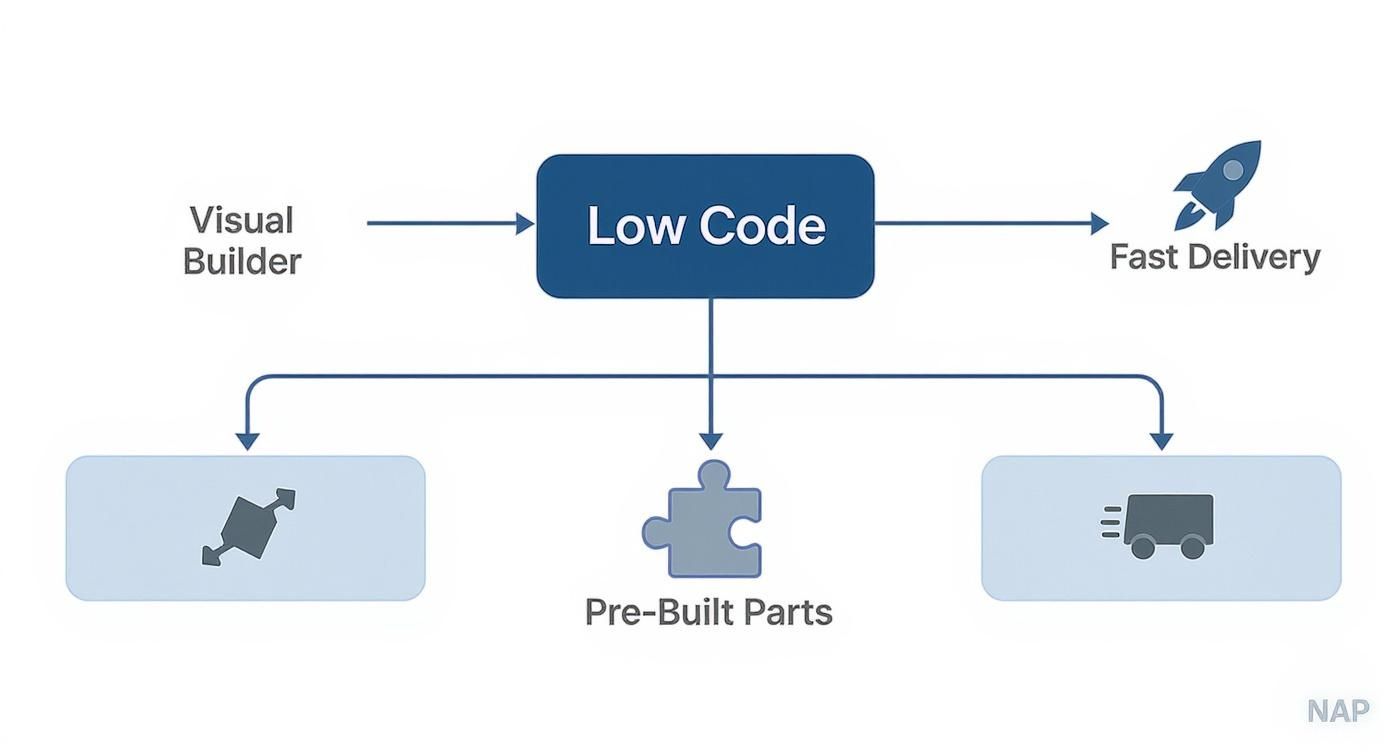what is low code development: A fast guide to building apps
Learn what is low code development and how it speeds app creation, boosts agility, and fits business needs with real-world use cases.

Low-code development is a way of building software that’s much more visual, cutting down heavily on the need for traditional, line-by-line coding. Think of it like building with an advanced LEGO kit where you have all sorts of specialised pieces, instead of having to mould each plastic brick from scratch. This approach lets both seasoned developers and business experts build applications faster using things like drag-and-drop interfaces.
What Does Low-Code Development Actually Mean?
At its heart, low-code development is a method that uses a graphical user interface (GUI) packed with pre-built modules and components to piece together applications. Instead of typing out thousands of lines of code, you’re visually connecting blocks of logic to create workflows, design user interfaces, and manage data. It seriously lowers the technical bar for who can build software.
It’s the perfect middle ground. At one end of the spectrum, you have traditional “full-code” development. This gives you total flexibility but demands deep programming knowledge and takes a lot more time. At the other end, you'll find tools like no-code mobile app builders, which let you create things with almost zero coding, but often come with more restrictions.
Low-code neatly bridges this gap. It gives you the speed of visual building but still lets professional developers jump in and write custom code for tricky logic or specific integrations when they need to. It’s this hybrid nature that makes it so incredibly versatile.
For a quick summary, here’s a look at the core principles of low-code in practice.
Low Code Development At A Glance
Essentially, it’s all about working smarter, not harder, by abstracting away the boilerplate stuff so teams can focus on what makes their application unique.
The Driving Force Behind Its Popularity
So why is everyone suddenly talking about low-code? The main reason is the relentless need for speed and agility in business. Companies have to innovate and adapt faster than ever, but traditional development cycles can be a major bottleneck. Low-code platforms tackle this problem head-on.
The momentum is undeniable. The UK low-code market hit about USD 1.13 billion in 2023 and is on track to reach USD 4.04 billion by 2030. That’s not just hype; it’s a sign of how deeply it’s being integrated into business strategies. You can find more detail on this growth in a recent UK market analysis on akveo.com.
This rapid growth is being fuelled by a few key advantages:
- Accelerated Delivery: Teams can build and launch applications in a fraction of the time it would take with conventional methods.
- Reduced Costs: Faster development and needing fewer highly specialised developer hours translates directly into lower project costs.
- Increased Collaboration: It creates a shared language for business stakeholders and IT teams, allowing them to work together to build solutions that actually solve the business problem.
By taking care of the more repetitive and tedious parts of coding, low-code development frees up your best technical talent to focus on the big-picture challenges—things like system architecture, security, and performance. It’s not about replacing developers; it’s about making them more powerful.
Understanding The Development Spectrum
To really get what low-code is all about, it helps to see where it fits in the bigger picture of software development. Think of it like cooking a meal. Your approach depends on your skills, how much time you have, and how fancy you want the final dish to be.
On one end of the spectrum, you have traditional or 'full-code' development. This is the equivalent of a professional chef making a gourmet meal entirely from scratch. They have absolute control over every raw ingredient and can create anything they can imagine. But it demands deep expertise, a lot of time, and painstaking attention to detail.
On the opposite end is no-code development. This is your microwave meal. It’s unbelievably fast and convenient, and you don't need any cooking skills. The trade-off? You’re stuck with what’s in the box. You can’t tweak the recipe or swap out ingredients. It’s brilliant for simple, specific jobs where speed is everything.
And right in the middle, you'll find low-code development. This is the gourmet meal kit. You get high-quality, pre-measured ingredients and a clear set of instructions, which speeds things up massively. You can still add your own creative touches—a unique spice, a different way of plating—but all the heavy lifting is done for you.
Finding The Right Fit For Your Project
Each method has its place, and picking the right one is a balancing act between speed, flexibility, and the technical skill you have on hand. There’s no single "best" option; it all comes down to what you’re trying to achieve.
Low code's true power lies in its balance. It offers the speed and accessibility of a visual builder while retaining the ability for developers to write custom code for unique features, providing a powerful middle ground that fits a huge range of business needs.
This concept map breaks down the core components of low-code development, showing its visual nature, its use of pre-built parts, and its sharp focus on getting things done quickly.

The diagram illustrates how these pieces come together to make the whole process more efficient, closing the gap between a great idea and a working application. This blend of speed and customisation is a key theme you’ll see when digging into a detailed comparison of https://www.derrick.dk/post/webflow-vs-bubble, two platforms that sit at different points on this very spectrum.
Key Trade-Offs To Consider
Making a smart decision means knowing what you’re giving up. While low-code platforms dramatically cut down development time, they can sometimes hide the underlying code, which might restrict what you can do in very specific, niche situations.
Here’s a quick breakdown:
- Full Code: Total flexibility and control, but it costs the most in time and technical skill.
- Low Code: A great balance of speed and customisation, making it perfect for most business apps and MVPs.
- No Code: The fastest way to get simple things done, but it’s the most limited when it comes to flexibility.
Ultimately, knowing these differences is vital for any team that wants to build more effectively. You can get a much deeper analysis in this guide comparing no-code, low-code, and AI app builders. The success of your project often starts with simply choosing the right tool for the job.
The Business Case For Adopting Low Code
So, we've talked about what low-code is, but the real question is why it’s catching on. It’s not just the latest tech trend. Companies are adopting low-code because it gives them a serious competitive edge and solves some very real business headaches.
The biggest driver? The relentless need for speed.
In a market that’s always shifting, traditional development cycles can feel like trying to turn a container ship. They're thorough, sure, but also slow and expensive. This often creates a massive bottleneck between a great idea and actually getting it into the hands of customers.
Low-code blows that bottleneck wide open. By swapping lines of code for visual models and ready-made components, businesses can build and launch anything from internal workflow tools to full-blown customer portals in a fraction of the time. This means you get to market faster, react to feedback quicker, and jump on opportunities while they're still hot.
Empowering Your Entire Team
Another huge win is how low-code opens up app development to more people. It gives rise to what we call citizen developers.
Think about the tech-savvy people in your business—the project managers, marketing experts, or operations analysts who know their department's problems inside and out. They have the ideas but not the coding skills to build the solution.
With low-code, they can. Suddenly, they’re able to build the exact automated workflow or custom dashboard they need, without waiting in a long queue for the IT department. This creates a powerful ripple effect:
- It frees up your professional developers. Your senior engineers can stop getting bogged down with smaller, departmental requests. Instead, they can focus their firepower on the heavy-duty stuff, like core system architecture, security, and complex, mission-critical projects.
- It leads to better, more relevant solutions. When the person experiencing the problem is the one building the fix, the end result is almost always a better fit for the real-world need. There's no "lost in translation" moment between the business team and the developers.
This doesn't make professional developers obsolete; it makes them more strategic. Low-code handles the repetitive grunt work, allowing your technical experts to step up and guide innovation across the entire company.
Driving Cost Efficiency and Future Growth
The financial argument for low-code is just as strong. When you can build things faster and rely less on a huge team of specialised developers, the cost savings start to add up quickly.
Projects that might have taken months of expensive development time can often be wrapped up in weeks. That dramatically lowers the investment needed to try out new digital ideas, which is why its adoption is skyrocketing.
In fact, forecasts predict that by 2025, a staggering 70% of all new applications built by businesses will use low-code or no-code tools. That’s a massive jump from less than 25% back in 2020. This isn't a niche trend; it’s becoming the standard, especially in places like the UK where businesses need to innovate fast with limited resources. If you want to dig deeper, esparkinfo.com offers more insights into this low-code trend.
Ultimately, low-code gives you a scalable way to grow. It lets you build, test, and iterate on new ideas without the crippling upfront costs that used to hold innovation back.
How Businesses Use Low Code In The Real World
 The theory behind low-code is interesting, but its real power comes to life when you see how businesses are actually using it. Across every industry, companies are adopting this approach to solve genuine problems, innovate faster, and just run a whole lot smarter. It's not just a niche tool for developers anymore; it’s becoming a strategic part of the entire organisation.
The theory behind low-code is interesting, but its real power comes to life when you see how businesses are actually using it. Across every industry, companies are adopting this approach to solve genuine problems, innovate faster, and just run a whole lot smarter. It's not just a niche tool for developers anymore; it’s becoming a strategic part of the entire organisation.
From scrappy startups to established digital agencies, the applications are as diverse as they are effective. Low-code gives teams the ability to build the specific tools they need without getting stuck in a long queue for the IT department.
This shift is especially noticeable in the UK, where IT departments are often swamped. They're facing huge backlogs of requests from different business units, a problem made worse by a real shortage of skilled developers. This bottleneck can bring crucial projects to a grinding halt. You can get a deeper look into this trend from insights on the UK's growing low-code market.
Building And Validating MVPs For Startups
For any startup, speed is everything. Getting a Minimum Viable Product (MVP) out the door is critical for proving an idea works, getting feedback from real users, and securing that all-important funding. Traditional development can take months and cost a small fortune, which is a risk most founders simply can’t afford.
This is where low-code completely changes the game.
- Problem: A FinTech startup has an idea for a new budgeting app. They need to launch a basic version quickly to see if people will actually use it before they pour serious money into a full build-out.
- Solution: Instead of hiring a dev team, the founders use a low-code platform to build a working MVP. Within a few weeks, they have an app with core features like transaction tracking and savings goals.
- Outcome: The startup gets their MVP to market, signs up its first 1,000 users, and walks into investor meetings with a tangible product and real user data. This is what helps them close their pre-seed funding round.
This kind of rapid cycle—build, test, learn, repeat—is exactly what startups need to survive and thrive. To get a feel for what’s possible, check out our guide on the best no-code apps to build your next startup.
Streamlining Internal Operations
Low-code isn't just for customer-facing products. It's an absolute powerhouse for creating internal tools that automate tedious work and make day-to-day operations more efficient. So many businesses are still stuck using a messy web of spreadsheets and clunky manual processes that are slow and prone to errors.
Low-code puts the power to build custom solutions directly into the hands of the operations teams who need them most. They can automate repetitive tasks, create custom dashboards, and connect different systems, often without writing a single line of code.
Think about a digital agency struggling with a messy client onboarding process.
- Problem: The agency’s process for bringing on new clients is a chaotic mix of emails, spreadsheets, and manual data entry. It’s slow, inconsistent, and gives a poor first impression.
- Solution: The operations manager, who knows the process inside-out, uses a low-code platform to build a centralised client onboarding portal. The new system automatically sends welcome emails, collects key info through forms, assigns tasks to the right people, and displays everything on a clean dashboard.
- Outcome: The agency cuts its client onboarding time by 60% and virtually eliminates manual errors. New clients get a smooth, professional experience from day one, and the team can focus on delivering great work instead of drowning in admin.
Integrating Low Code Into Your Business Strategy
Bringing any new technology into the fold is about more than just picking a cool tool; you need a solid game plan. To take low-code from a neat idea to something that delivers real, lasting value, you have to think strategically about how it slots into your company.
First things first: choosing the right platform. This decision has to be about more than a flashy user interface. You need to evaluate platforms based on criteria that actually line up with your long-term business goals. Look for providers with a proven track record for scalability, enterprise-grade security to keep your data safe, and powerful integration capabilities to connect with the software you already use every day.

With so many options on the market, each with its own strengths, it can be tough to know where to start. The key is to focus on what matters most for your specific operational needs and future ambitions.
Here's a table to help guide your evaluation process:
Choosing The Right Low Code Platform Key Factors
Ultimately, the best platform is the one that fits your unique business context—not just the one with the most features.
Establishing Clear Governance
When you give more people the power to build applications, you also open the door to new risks. Without a clear set of rules, you can quickly find yourself dealing with a chaotic mess of unmanaged apps, often called 'shadow IT'. It’s a recipe for security holes and maintenance nightmares.
To sidestep this chaos, you need to establish clear governance from day one. This isn't about killing creativity; it's about creating a safe playground for it. Good governance simply defines:
- Who gets to build applications and what level of access they have.
- What kind of data is approved for use in low-code apps.
- The review and approval process before an app goes live.
- Security protocols and standards every application must meet.
This framework ensures that as your team embraces what is low code development, they're doing it in a secure, organised, and scalable way.
Fostering a Collaborative Culture
Successful low-code adoption is built on collaboration, not conflict. It should be a bridge that connects business teams and IT departments, not a battleground. When you get it right, low-code becomes a shared language that helps both sides hit their targets faster.
Business users know the problems they need to solve inside and out, while IT brings the crucial expertise in security, architecture, and integration. A collaborative culture thrives when this partnership is encouraged. One great way to do this is by setting up a centre of excellence where IT can guide and support citizen developers, making sure the solutions they build are not only innovative but also robust, secure, and in line with the company’s tech standards. Finding people with the right collaborative mindset is key, and you can learn more about identifying these skills by understanding how to interview no-code developers, who often possess similar problem-solving traits.
By fostering this synergy, low code becomes a powerful tool for business-led innovation, guided and secured by IT. This collaborative approach unlocks its full potential, turning great ideas into impactful applications without compromising on quality or security.
Answering Your Questions About Low Code
Whenever a powerful new way of building things comes along, it’s only natural to have a few questions. If you’re thinking about bringing low-code into your business, you're probably wondering about security, performance, and what it all means for your existing team.
Let's cut through the noise and tackle some of the most common concerns people have. Getting clear on these points is the first step in moving from just being curious about low-code to making a smart, strategic decision for your company.
Is Low Code Actually Secure?
This is usually the first question on everyone's mind: can you really trust applications built on these platforms? The short answer is a confident yes, but with a caveat—you need to choose the right platform and use it wisely.
Reputable low-code platforms are built from the ground up with enterprise-grade security in mind. Think robust features like role-based access controls, detailed audit logs, and compliance with major standards like ISO 27001. These providers pour huge resources into security, often creating a more solid foundation than a small in-house team could ever build from scratch.
But the platform is only half the story. Security is always a shared responsibility. The real key to safety is pairing a secure platform with strong internal rules and processes. This ensures every single application your team builds is up to your organisation’s specific security standards.
Can Low Code Applications Scale?
There’s a lingering myth that low-code is just for small, throwaway apps. While that might have been true in its early days, modern platforms are built for the big leagues.
Many of today's leading low-code platforms are designed to build and support complex, high-traffic applications for large enterprises. They can handle significant user loads and large datasets without breaking a sweat.
The trick is to do your homework. When you're looking at different platforms, pick one with a proven track record of scalability and high performance. Ask for case studies from companies your size, and take a close look at the platform's architecture to make sure it can grow with you. It’s not a question of if low-code can scale, but whether you've chosen a platform built for it.
Does Low Code Make Developers Obsolete?
This is probably the biggest misconception out there. The idea that low-code is coming to replace professional developers couldn't be more wrong. In reality, low-code doesn't replace developers; it elevates them.
It takes over the repetitive, soul-crushing coding tasks that eat up so much time in a development cycle. This frees up your professional developers to focus on the high-value, strategic work that genuinely needs their deep expertise.
This simple shift allows them to focus on what really matters:
- Complex system architecture and designing the robust back-end solutions that power everything.
- Building custom integrations with other business-critical systems.
- Optimising application performance and locking down security.
- Driving real innovation by exploring new and emerging technologies.
Instead of making them obsolete, low-code transforms your developers into force multipliers for the entire business. They become the guides for citizen developers, the architects of best practices, and the go-to experts for solving the toughest technical problems.
Ready to build a high-performing Webflow site that turns your vision into a conversion machine? At Derrick.dk, we specialise in expert, low-code Webflow development for startups and growing businesses. Book a discovery call today and let's create a website that works as hard as you do.
Webflow Developer, UK
I love to solve problems for start-ups & companies through great low-code webflow design & development. 🎉

.jpg)









